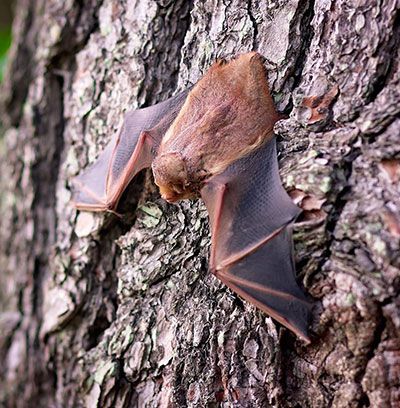Did you know?

- Bats are among the most gentle and beneficial of all mammals. In particular female bats are very caring mothers.
- Insect-eating bats are essential predators of night-flying insects, including mosquitoes and beetles.
- Fruit and nectar eating bats are among the most important seed-dispersers and pollinators of tropical rain forest trees and other plants. Such diverse plants as the saguaro cactus, agave, and fig tree depend on bats for their survival.
- Bats are not a major source of rabies. Dogs, cats, raccoons and skunks are much more likely to have the disease. Fewer than one half of one percent of bats contract rabies. Less than a dozen people in the U.S. and Canada are believed to have died from rabies form bats in the past four decades. If a bat does get rabies, he does not become aggressive and dies quickly.
- Bats are exceptionally clean and engage in frequent grooming.
- Bats have excellent eyesight and use high frequency sounds to navigate. They do not become entangled in your hair.
Notes by Glenn Olsen
One of the most interesting and often-seen types of wildlife at night is bats. We most often notice bats flying erratically at dusk or early morning in our neighborhoods. Bats roost (sleep) during the day and we can find them in many different habitats including cavities in trees, behind the loose bark of trees, in tree leaves, on tree trunks, under bridges and in buildings. Perhaps the best known bat in Texas is the Mexican/Brazilian free-tailed bat (Tadarida brasiliensis). This is the species that many people go to the Waugh Street bridge in Houston or the Congress Street bridge in Austin to watch leave their roost site under the bridges at dusk. This species is highly migratory, arriving in late February-early March to spend the summer in Texas and breed. In the fall they migrate south to Mexico for the winter. The Mexican/Brazilian free-tailed bat is our state flying mammal.
Bats in general are very beneficial mammals that consume hundreds of thousands of insects per night, including mosquitos, moths, and beetles. According to the Texas Parks and Wildlife Department studies have shown that the agricultural value of insect control by bats is $1.4 billion annually in Texas alone!
We have several other bat species but these do not receive the attention that the above-mentioned species does. A few of these are the eastern red bat, the northern yellow bat, big brown bat, and the evening bat. These are the ones we are more likely to see in our neighborhoods. Thirty-three species of bats have been recorded in the state but several of these are rare occurrences.
Species Found in Houston
Tree Branch Roosters
-
Eastern Red Bat
4"-5", reddish brown. Roosts in foliage of deciduous trees.
-
Seminole Bat
4"-5", fur is rich mahogany brown. Likes to roost in Spanish moss.
-
Hoary Bat
4"-6", yellowish fur is heavily frosted. Largest local bat. Roosts in evergreens.
-
Northern Yellow Bat
4". Roosts in dead palm leaves and Spanish moss.
Cavity Roosters (tree crevices, hollows)
-
Big Brown Bat
4"-5", dark brown fur. Also roosts in attics and under house eaves.
-
Evening Bat
3"-4", reddish brown to dark brown fur. Most likely user of bat houses.
-
Tricolored Bat
3"-3.5". Our smallest bat with reddish to light brown fur.
Uncommon Species
-
Silver-haired Bat
4", fur nearly black with silver tips. Solitary, slow flier.
-
Free-tailed Bat
4", brownish-grey. This is a subspecies of Austin's famous bat. Roosts under bridges and also uses bat houses.
Bat Houses
Bat houses have been in use in Europe for over 60 years. In the U.S. they are a fairly recent phenomenon. Success depends upon many factors, such as the species of bats in your area, style of house, location, and proximity to water. We recommend you check with Bat Conservation International for details. In addition to selling houses and house plans, they are in the midst of a research project on bat-housing and can offer you the best advice on what type of house to use. Providing suitable roosting habitat is the best way to encourage bats. Of particular importance is to let the lower dried palm fronds remain on palm trees. In addition, any kind of water feature such as a pond or swimming pool is also an excellent lure.


